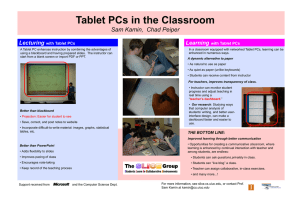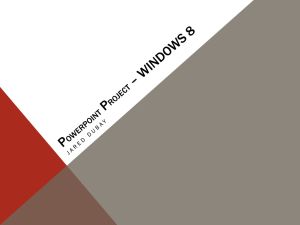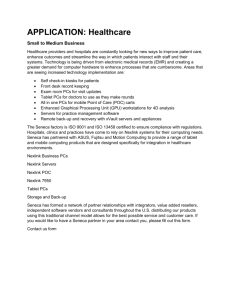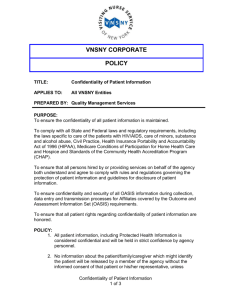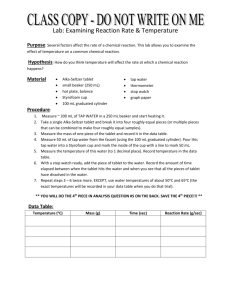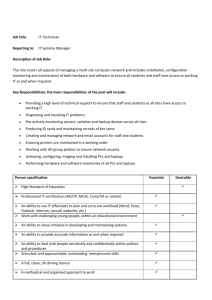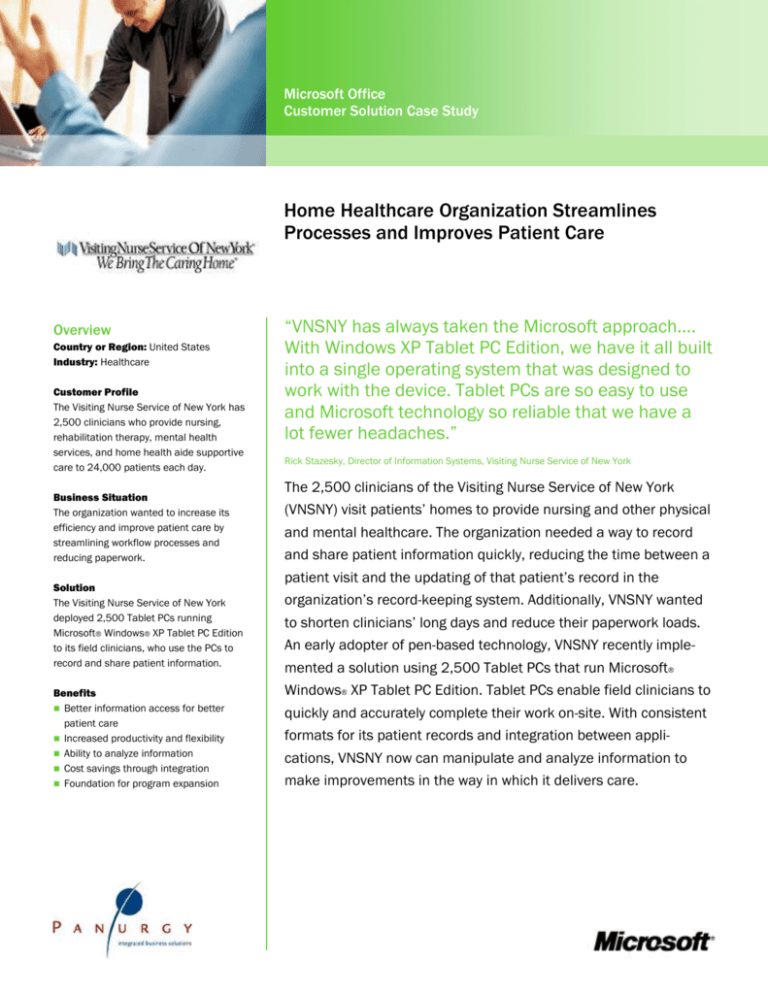
Microsoft Office
Customer Solution Case Study
Home Healthcare Organization Streamlines
Processes and Improves Patient Care
Overview
Country or Region: United States
Industry: Healthcare
Customer Profile
The Visiting Nurse Service of New York has
2,500 clinicians who provide nursing,
rehabilitation therapy, mental health
services, and home health aide supportive
care to 24,000 patients each day.
Business Situation
The organization wanted to increase its
efficiency and improve patient care by
streamlining workflow processes and
reducing paperwork.
Solution
The Visiting Nurse Service of New York
deployed 2,500 Tablet PCs running
Microsoft® Windows® XP Tablet PC Edition
to its field clinicians, who use the PCs to
record and share patient information.
Benefits
Better information access for better
patient care
Increased productivity and flexibility
Ability to analyze information
Cost savings through integration
Foundation for program expansion
“VNSNY has always taken the Microsoft approach….
With Windows XP Tablet PC Edition, we have it all built
into a single operating system that was designed to
work with the device. Tablet PCs are so easy to use
and Microsoft technology so reliable that we have a
lot fewer headaches.”
Rick Stazesky, Director of Information Systems, Visiting Nurse Service of New York
The 2,500 clinicians of the Visiting Nurse Service of New York
(VNSNY) visit patients’ homes to provide nursing and other physical
and mental healthcare. The organization needed a way to record
and share patient information quickly, reducing the time between a
patient visit and the updating of that patient’s record in the
organization’s record-keeping system. Additionally, VNSNY wanted
to shorten clinicians’ long days and reduce their paperwork loads.
An early adopter of pen-based technology, VNSNY recently implemented a solution using 2,500 Tablet PCs that run Microsoft®
Windows® XP Tablet PC Edition. Tablet PCs enable field clinicians to
quickly and accurately complete their work on-site. With consistent
formats for its patient records and integration between applications, VNSNY now can manipulate and analyze information to
make improvements in the way in which it delivers care.
Situation
Since 1893, the Visiting Nurse Service of
New York (VNSNY) has been providing home
healthcare to patients in New York City.
Today, the organization’s 2,500 clinicians
deliver home healthcare services ranging
from pediatric to elder care, psychiatric
assessments to AIDS treatment, and short–
term interventions to long-term management.
VNSNY clinicians visit patients throughout
New York City’s five boroughs, Westchester
County, and Nassau County on Long Island.
VNSNY is the largest home healthcare
organization in the United States; in a typical
year, its clinicians make more than 2 million
visits to more than 100,000 patients.
while with the patient and try to record it later
from memory.
One of the organization’s strengths is its drive
to develop innovative ways of using technology to improve patient outcomes. VNSNY
leads the way when it comes to testing and
implementing new methods of delivering
patient care, enhancing communications with
its physician and hospital partners, and promoting operational efficiency.
Additionally, there used to be a delay of up to
five days between a patient visit and when
information from that visit was accessible in
VNSNY’s computer system. The delays meant
that the medical information available was
frequently outdated, so subsequent clinicians
were visiting patients without the most
recent, relevant information about a patient’s
treatment. “Our clinicians were basically
operating in isolation, which just didn’t make
sense because one patient often is served by
several of our clinicians, who all share
responsibility for the patient’s well-being,”
says Rick Stazesky, Director of Information
Systems for the Visiting Nurse Service of
New York. “Our organization strives to have
each visit build on the last, promoting better
patient care, but we had no systematic way
for our clinicians to pass on information
regarding patients unless they left
handwritten notes for one another at the
patients’ homes.”
Regulatory agencies require healthcare
organizations to complete a substantial
amount of documentation for each home
visit; the paperwork is intended to capture
clinical data as well as information related to
billing and insurance.
Delays in the availability of information also
hindered VNSNY’s ability to promptly send
invoices. “Healthcare is a low-margin
industry, so we also were looking for a way to
have our invoices follow treatment as closely
as possible,” says Stazesky.
Clinicians used to record notes by hand
during their daily patient rounds and also
attempt to fill out forms while attending to
patients. At the end of the workday, clinicians
would then call or visit one of five regional
VNSNY offices to update each patient’s file in
the main VNSNY system. The company
wanted to give its clinicians a way to record
information electronically while still at a
patient’s home to reduce the number of
hours in a typical clinician’s workday. Being
able to enter data while on-site would also
increase the information’s accuracy because
clinicians would not skip the data entry
Another significant deficiency of the paper–
based system was that it did not allow VNSNY
to gather information consistently from its
2,500 clinicians. Most patient information
was written down in narrative form, rendering
it useless for any sort of analysis. One of
VNSNY’s goals was to compile an electronic
medical patient record. “We had this wealth
of patient documentation that we couldn’t
take advantage of because it was in narrative
form, some of it largely illegible,” says
Stazesky. “We wanted to use that information
as a strategic tool for developing best
practices for treatment and directing the
course of our organization.”
Solution
Moving to the Tablet PC
VNSNY took a phased approach to establishing its pen-based, remote-computing environment: It added one significant piece of
functionality each year to take advantage of
hardware or software advancements. “We
didn’t want to follow the ‘big bang’ strategy of
upgrading our technology because we felt it
would be both easier on our patients and
better for our clinicians if we eased them into
it,” says Stazesky.
VNSNY decided to investigate mobile technology to meet its clinical and administrative
needs. “Mobile technology is useful for the
Visiting Nurse Service of New York because
we are a field-based organization, with large
numbers of clinicians, including nurses and
physical, speech, and occupational therapists,” says Stazesky. “Giving our field staff
tools that travel with them seemed like a
good way to cut down on paperwork while
providing us with consistent information at an
enterprise level.”
In late 2001, the organization began a large
development phase that involved the release
of VNSNY’s Visit Documentation Module, an
application that was scheduled to be completed around 2002. The timing happened to
coincide with the end of the useful life cycle
of the organization’s pen machines. Fujitsu
had provided VNSNY with the pen machines,
and it was at this time that Fujitsu introduced
the organization to Tablet PCs, which were
new to the market.
In 1995, VNSNY first decided to try out
portable computers for its clinicians, but after
some initial testing, the organization instead
turned to early pen-based technology from
Fujitsu. Pen-based technology not only was
more comfortable for the clinicians to use,
but also less intrusive during a patient visit.
With traditional portable computers, clinicians had difficulty keying in information
while administering hands-on care. Because
patients were already used to clinicians using
clipboards and pens, they perceived penbased technology for information entry as
much more familiar and less threatening.
Tablet PCs are fully functional computers that
support mobility with built-in wireless capabilities and a long battery life. Mobile workers
can use Tablet PCs as they would conventional portable PCs with standard keyboards,
or they can use the computers as a slate with
“pens” that have writing and drawing (“ink”)
capabilities. The Tablet PCs run the
Microsoft® Windows® XP Tablet PC Edition
operating system, which is built on top of
Windows XP Professional and offers advanced handwriting and speech recognition
capabilities for creating, storing, and transmitting handwritten notes and voice input.
“We often serve people who aren’t necessarily comfortable with technology, so we
want to create the most unobtrusive, comfortable atmosphere for our patients as
possible,” explains Stazesky. “Finding a flat
surface for setting up a portable computer
and then typing away just wasn’t conducive
to a positive patient experience.”
VNSNY took an immediate interest in the new
technology, especially after learning that
Microsoft had developed a version of the
Windows XP operating system that was
embedded into each Tablet PC. “The fact that
Microsoft was making a major strategic
commitment to mobile devices convinced us
that Tablet PCs were a good choice for us,”
Since the mid-1990s, VNSNY has been working to eliminate its clinicians’ use of paper
forms. The organization wanted to help its
clinicians spend their days more efficiently,
with a greater proportion of time devoted to
patient care, rather than paperwork.
“The fact that Microsoft
was making a major
strategic commitment to
mobile devices convinced us that Tablet
PCs were a good choice
for us.”
Rick Stazesky, Director of Information
Systems, Visiting Nurse Service of New York
says Stazesky. “We soon saw that Tablet PCs
were great next-generation devices that
would allow us to do things we never could do
with our remote-computing system before.”
The functionalities that were most important
to VNSNY included speech recognition, significantly improved handwriting recognition,
and the ability to run the full feature set of
Microsoft Office XP Professional on the
remote device. Because the organization’s
previous pen-based system could not run any
version of the Office programs, translating
information into other formats had been
difficult. “The Tablet PC represented the last
piece of the puzzle. With it, we could reach
our goal of effectively building an electronic
patient medical record,” says Stazesky.
Putting the Pieces in Place
To take advantage of economies of scale,
VNSNY purchased 2,000 Tablet PCs from
Fujitsu at once and turned to PanurgyOEM, a
managed services provider, for computer
storage and distribution. PanurgyOEM put the
VNSNY standard image on each computer
and shipped groups of them in installments
to VNSNY’s regional offices. The organization
deployed the Tablet PCs over the course of a
year, adding another 500 computers near
the end of the project and wrapping up the
deployment in May 2004.
To meet the information collection needs
specific to its industry, VNSNY developed its
own remote-computing applications, using
the Microsoft Visual Basic® development
system version 6.0 and a Microsoft Access
2002 database. The remote-computing
applications work with VNSNY’s internally
built medication database, which has more
than 200,000 entries. The database enables
clinicians to check a patient’s medications for
duplicate therapy and drug-to-drug interactions, without having to carry around
medical reference books and researching
possible drug interactions each time a
medication is added.
VNSNY has configured its Tablet PCs as
remote, stand-alone systems. Clinicians
upload and download patient information to
and from the main database over standard
dial-up line transfers or by going to a VNSNY
regional office and using an 802.11b wireless
connection to the VNSNY intranet. The
organization is considering the
implementation of a wireless wide area
network to further improve the speed and
convenience of information transfer.
Securing the Mobile Environment
Ensuring that it is doing all that it can to
protect its patient information is imperative
for VNSNY. The Tablet PCs have multitiered
security levels, which help the organization
adhere to the regulations of the Health
Insurance Portability and Accountability Act of
1996 (HIPAA). VNSNY has configured the
Tablet PCs so that clinicians need a name
and password just to get the Windows XP
Tablet PC Edition operating system to start;
clinicians then need to supply another name
and password to access the applications that
run on the Tablet PC. For certain components
of the applications, users have to enter a
personal identification number (PIN), which
acts as an electronic signature. VNSNY also is
considering the use of biometrics as a
potential security measure that would further
protect sensitive patient information.
Additionally, VNSNY uses the encryption
features in Windows XP to safeguard
sensitive information in the event that a
Tablet PC is stolen or lost.
Using Tablet PCs in the Field
With the Tablet PCs, VNSNY’s clinicians can
use the productivity tools in Microsoft Office
XP Professional, including programs such as
Microsoft Excel, Word, and the PowerPoint®
presentation graphics program. With the
Tablet PC software’s native ink capabilities,
“Anything that used to
be done on paper now is
handled through the
Tablet PC.”
Rick Stazesky, Director of Information
Systems, Visiting Nurse Service of New York
clinicians can use the pen to control the
computer and applications, as well as input
regular handwriting, which can then be
converted into typed text. Also, the organization now relies on Microsoft Outlook® Web
Access, which makes it possible for clinicians
to send and receive e-mail messages from
any remote location in which they have
Internet access. Additionally, VNSNY field
clinicians can quickly and easily get access to
all of the documents and information on the
organization’s intranet, which uses Microsoft
Windows SharePoint® Services.
Because its clinicians already were fairly
familiar with both the Windows environment
and pen-based machines, VNSNY did not
have to conduct much training on the Tablet
PCs. VNSNY provided some basic training on
the Windows operating system for those who
were unfamiliar with it. The organization also
spent three hours orienting users to the
physical features of the new devices, followed
by three half-day sessions on the new, internally developed applications.
VNSNY clinicians now use their Tablet PCs for
activities such as completing visit notes or
vouchers for reimbursement. They review
caseloads and plan their schedules each
week by using information that they pull up
on their Tablet PCs. “Anything that used to be
done on paper now is handled through the
Tablet PC,” says Stazesky.
Benefits
With the introduction of Tablet PCs running
Windows XP Tablet PC Edition, VNSNY now
has a means of delivering better care to its
patients through accurate, up-to-date
information. The organization also benefits
from a body of clinical information that is
highly structured, can be shared easily, and is
in a consistent format that facilitates
business and clinical analysis.
Better Information Access for
Better Care
By having technology tools at their fingertips,
clinicians can check in with VNSNY before
patient visits to make sure that they have
reviewed the most recent patient information.
If, for example, a patient receives care twice
a day from two different clinicians, those two
caregivers now can easily communicate with
each other before making contact with the
patient. Clinicians can share test results and
concerns about any new health issues, which
helps patients receive more consistent care.
“This never could have happened before the
Tablet PCs,” says Stazesky. “We used to have
to leave notes in conspicuous spots in
patients’ homes to share information. Using
Outlook Web Access means that our clinicians have a single, more discreet source for
up-to-date information.”
Beyond day-to-day patient information,
clinicians use their Tablet PCs for sending
and receiving critical medical information,
such as guidelines and training updates.
Having an effective e-mail tool also gives
them the opportunity to communicate with
others in the healthcare field. “The Tablet PC
solution allows us to enhance the compatibility between our back office, our field clinicians, and other patient care stakeholders,”
says Stazesky.
VNSNY also has found that automating how it
collects patient information has been a
decided advantage in addressing ongoing
regulatory demands and documentation
requirements. “For us, Tablet PCs are a long–
term strategic investment, with our break–
even point spread out over a long period. In
the meantime, we’re able to increase the
consistency of our care delivery across a
diversified work force—clinicians are no
longer islands unto themselves but rather
are interconnected,” says Stazesky.
“We’re able to increase
the consistency of our
care delivery across
a diversified work
force—clinicians are no
longer islands unto
themselves but rather
are interconnected.”
More Time Spent on Patient Care
To streamline their recording processes,
VNSNY clinicians use programs such as
Excel, Word, and PowerPoint as well as
Outlook Web Access, which helps them send
and receive e-mail messages remotely. “It’s a
huge time-saver for clinicians to be able to
send and receive e-mail wherever they
connect, and their e-mail is synchronized
automatically whenever they log on,” says
Stazesky.
Rick Stazesky, Director of Information
Systems, Visiting Nurse Service of New York
Tablet PCs also help ease the complicated,
time-consuming Medicare reimbursement
process for VNSNY clinicians. Part of the
process involves completing the Outcome
and Assessment Information Set (OASIS),
which is a federally mandated assessment
tool for home health agencies. OASIS, a 25page form, must be filled out early in the
treatment period for each patient. OASIS
includes instructions that require clinicians to
sift back and forth through the document to
enter different levels of detail, depending on
the patient’s situation. Now, however, the
Tablet PC OASIS application guides clinicians
through the assessment, helping them deal
with the layers of “paperwork” more efficiently. “I don’t have to spend much time
writing the documentation because everything is basically in the application and I can
click on it like using a mouse,” says Lisa
Felszer, Registered Nurse and per diem coordinator of care at VNSNY. Having OASIS in an
electronic format also spares clinicians from
having to physically carry the large quantity of
paper that the previous system required.
The use of Windows SharePoint Services for
centralized document management enables
VNSNY professionals to quickly and easily tap
into all of the documents and information on
the organization’s intranet. “Clinicians don’t
have to go back to a regional office to get
their hands on information,” says Stazesky.
“And we’re able to enforce version control, so
they know that our documents are as up-todate and accurate as possible.”
Says Felszer, “When we were using paper,
every diagnosis had a different paper form to
fill out. If you didn’t go to the office, you didn’t
have the right form.”
In addition to enabling VNSNY clinicians to be
more productive, Tablet PCs also contribute
to their flexibility. “We’re running a much
tighter organization now that our field clinicians have the ability to communicate with
the office and one another anytime throughout the day,” says Stazesky. “It was typical for
a clinician to check in through our e-mail
system in the morning before leaving for the
first appointment and then again at the end
of the day, often by stopping in at a regional
office. But with Tablet PCs, clinicians can log
on from home. It gives them a tremendous
amount of freedom to accomplish their tasks
when it’s easiest for them.” That convenience
is extended by the support in Windows XP
Tablet PC Edition for industry-standard power
management technology, which enables the
operating system to regulate power to the
computer and extend battery life for mobile
users.
Information Analysis
Having its patient data in a consistent, readable format assists VNSNY in its effort to continually improve its quality of service. “Now
we can study how patients are responding to
care and make adjustments to that care in
order to achieve faster, better results,” says
Stazesky. For instance, the organization
might look at the feedback regarding patients
with type 2 diabetes and determine whether
the protocol needs to be adjusted. Continues
Stazesky, “Standardizing on tools such as
Microsoft Office XP programs supports our
desire to advance our business. Because of
our consistent tool set and our use of
templates, our information is trustworthy and
can be used for decision making both at a
corporate level and at a clinician level.”
Cost Savings Through Integration
VNSNY already realized cost savings by
making the shift from paper entry to penbased computers because the organization
eliminated certain back-office functions such
as data entry of the handwritten documentation. “Before initial deployment, VNSNY
needed three business staff for every 20
caregivers, and now we need one person for
every 40 caregivers,” says Stazesky. “Our
remaining business staff members are used
in a more productive customer-relationship
management role.”
However, the organization’s move to Tablet
PCs is enabling VNSNY to make the most of
integrated technology and eliminating the
need for third-party software. “VNSNY has
always taken the Microsoft approach—our
pen-based machines ran Windows 95.
However, we had to spend the time and
money to license third-party add-in software
for integrating handwriting recognition or pen
features with the operating system,” says
Stazesky. “With Windows XP Tablet PC
Edition, we have it all built into a single
operating system that was designed to work
with the device. Tablet PCs are so easy to use
and Microsoft technology so reliable that we
have a lot fewer headaches.”
Stazesky adds, “We view our investment
in technology as a capital expense that
keeps us ahead of the pack and makes us
leaders in the home healthcare industry in
the United States.”
Foundation for Program Expansion
VNSNY hopes to take further advantage of its
mobile technology. The organization currently
is looking into using Tablet PCs to store and
transmit digital images of wound care, as well
as to connect with telecommunicationenabled healthcare equipment installed in
patients’ homes.
Additionally, VNSNY is moving toward a goal
of implementing electronic-learning practices
using e-learning software and devices by the
end of 2004. “Our clinicians are always looking to further their knowledge, and we want
to make it easy for them by enabling mobile
learning,” says Stazesky. The organization
wants clinicians to be able to take a course
and its concluding test at their convenience,
rather than scheduling training classes that
clinicians have to make time for and physically attend. Concludes Stazesky, “E-learning
will enable VNSNY to deliver timely training
more cheaply and quickly than before, and
Tablet PC technology makes it possible.”
For More Information
Microsoft Office
For more information about Microsoft
products and services, call the Microsoft
Sales Information Center at (800) 4269400. In Canada, call the Microsoft
Canada Information Centre at (877) 5682495. Customers who are deaf or hard-ofhearing can reach Microsoft text telephone
(TTY/TDD) services at (800) 892-5234 in
the United States or (905) 568-9641 in
Canada. Outside the 50 United States and
Canada, please contact your local
Microsoft subsidiary. To access information
using the World Wide Web, go to:
www.microsoft.com
Microsoft Office is the business world’s
chosen environment for information work
that provides the software, servers, and
services that help you succeed by transforming information into impact. For more
information about Microsoft Office, go to:
www.microsoft.com/office
For more information about PanurgyOEM
products and services, call (973) 6254056, or visit the Web site at:
www.panurgyoem.com
For more information about Visiting Nurse
Service of New York products and services,
call (888) 867-1225, or visit the Web
site at:
www.vnsny.org
Software and Services
Hardware
Microsoft Office XP Professional
Microsoft Visual Basic 6.0
Microsoft Windows XP Tablet PC Edition
Technologies
− Microsoft Outlook Web Access
− Microsoft Windows SharePoint
Services
© 2004 Microsoft Corporation. All rights reserved.
This case study is for informational purposes only.
MICROSOFT MAKES NO WARRANTIES, EXPRESS
OR IMPLIED, IN THIS SUMMARY.
Microsoft, Outlook, PowerPoint, SharePoint, Visual
Basic, and Windows are either registered
trademarks or trademarks of Microsoft
Corporation in the United States and/or other
countries. The names of actual companies and
products mentioned herein may be the
trademarks of their respective owners.
Document published September 2004
Fujitsu Stylistic ST4000 Tablet PC
Partners
PanurgyOEM
Fujitsu

